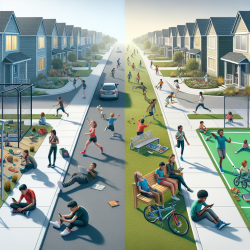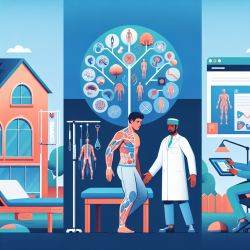Introduction
In the quest to enhance the health and well-being of children, understanding the factors contributing to physical inactivity is crucial. Recent research titled "The proportion of youths’ physical inactivity attributable to neighbourhood built environment features" provides valuable insights into how neighborhood characteristics can influence youth physical activity levels. This blog explores the study's findings and discusses how practitioners can leverage this knowledge to improve outcomes for children.
Key Findings from the Study
The study, conducted by Laxer and Janssen, examined the relationship between neighborhood built environment features and physical inactivity among Canadian youth aged 11-15 years. The research identified three primary neighborhood characteristics that significantly influence physical inactivity:
- Walkability: Youth living in more walkable neighborhoods were found to have a 28-44% higher risk of being physically inactive compared to those in less walkable areas.
- Density of Cul-de-sacs: A lower density of cul-de-sacs was associated with a 28-32% higher risk of inactivity.
- Park Space: Surprisingly, neighborhoods with moderate to high park space had a 28-37% higher risk of youth inactivity.
Implications for Practitioners
Understanding these findings can guide practitioners in developing strategies to promote physical activity among youth. Here are some practical steps:
- Advocate for Urban Planning: Encourage urban planners to design neighborhoods with a balanced mix of walkability and safe play areas. Incorporating cul-de-sacs and ensuring accessible recreational spaces can promote active play.
- Community Engagement: Work with local communities to create awareness about the importance of neighborhood design in promoting physical activity. Engage parents and community leaders in advocating for changes that support active lifestyles.
- Further Research: Practitioners should consider conducting localized studies to assess the specific needs and characteristics of their communities. This can help tailor interventions to the unique context of each neighborhood.
Encouraging Further Research
While this study provides significant insights, it also highlights the need for further research to explore the complex relationship between neighborhood environments and youth physical activity. Practitioners are encouraged to collaborate with researchers to investigate additional factors that may influence physical activity, such as socioeconomic status, cultural norms, and access to recreational facilities.
Conclusion
The study by Laxer and Janssen underscores the importance of considering neighborhood built environments when addressing youth physical inactivity. By leveraging these findings, practitioners can advocate for changes that create healthier, more active communities for children.
To read the original research paper, please follow this link: The proportion of youths’ physical inactivity attributable to neighbourhood built environment features.










